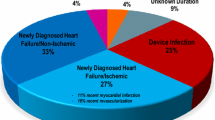Abstract
Background
Implantable cardioverter defibrillators (ICDs) are designed to deliver shocks or antitachycardia pacing (ATP) in the event of ventricular arrhythmias. During follow-up, some ICD recipients experience the sensation of ICD discharge in the absence of an actual discharge (phantom shock). The aim of this study was to evaluate the incidence and predictors of phantom shocks in ICD recipients.
Methods
Medical records of 629 consecutive patients with ischaemic or dilated cardiomyopathy and prior ICD implantation were studied.
Results
With a median follow-up of 35 months, phantom shocks were reported by 5.1 % of ICD recipients (5.7 % in the primary prevention group and 3.7 % for the secondary prevention group; p=NS). In the combined group of primary and secondary prevention, there were no significant predictors of the occurrence of phantom shocks. However, in the primary prevention group, phantom shocks were related to a history of atrial fibrillation (p=0.03) and NYHA class <III (p=0.05). In the secondary prevention group, there were no significant predictors for phantom shocks.
Conclusion
Phantom shocks occur in approximately 5 % of all ICD recipients. In primary prevention patients, a relation with a history of atrial fibrillation and NYHA class <III were significant predictors for the occurrence of phantom shocks. In the secondary prevention patients, no significant predictors were found.

Similar content being viewed by others
References
Moss AJ, Zareba W, Hall WJ, et al. Prophylactic implantation of a defibrillator in patients with myocardial infarction and reduced ejection fraction. N Engl J Med. 2002;346(12):877–83.
Lee DS, Green LD, Liu PP, et al. Effectiveness of implantable defibrillators for preventing arrhythmic events and death: a meta-analysis. J Am Coll Cardiol. 2003;41(9):1573–82.
Bardy GH, Lee KL, Mark DB, et al. Amiodarone or an implantable cardioverter-defibrillator for congestive heart failure. N Engl J Med. 2005;352(3):225–37.
Zipes DP, Camm AJ, Borggrefe M, et al. ACC/AHA/ESC 2006 Guidelines for Management of Patients With Ventricular Arrhythmias and the Prevention of Sudden Cardiac Death: a report of the American College of Cardiology/American Heart Association Task Force and the European Society of Cardiology Committee for Practice Guidelines (writing committee to develop Guidelines for Management of Patients With Ventricular Arrhythmias and the Prevention of Sudden Cardiac Death): developed in collaboration with the European Heart Rhythm Association and the Heart Rhythm Society. Circulation. 2006;114(10):e385–484.
van Welsenes GH, Borleffs CJ, van Rees JB, et al. Improvements in 25 years of implantable cardioverter defibrillator therapy. Neth Heart J. 2011;19(1):24–30.
Kowey PR, Marinchak RA, Rials SJ. Things that go bang in the night. N Engl J Med. 1992;327(26):1884.
Swygman CA, Link M, Cliff D, et al. Incidence of phantom shocks in patients with implantable cardioverter defibrillators. Pacing Clin Electrophysiol. 1998;21:810. Ref Type: Abstract.
Wojcicka M, Lewandowski M, Smolis-Bak E, et al. Psychological and clinical problems in young adults with implantable cardioverter-defibrillators. Kardiol Pol. 2008;66(10):1050–8.
Bhandari AK, Anderson JL, Gilbert EM, et al. Correlation of symptoms with occurrence of paroxysmal supraventricular tachycardia or atrial fibrillation: a transtelephonic monitoring study. The Flecainide Supraventricular Tachycardia Study Group. Am Heart J. 1992;124(2):381–6.
Kang Y. Relation of atrial arrhythmia-related symptoms to health-related quality of life in patients with newly diagnosed atrial fibrillation: a community hospital-based cohort. Heart Lung. 2006;35(3):170–7.
Prudente LA, Reigle J, Bourguignon C, et al. Psychological indices and phantom shocks in patients with ICD. J Interv Card Electrophysiol. 2006;15(3):185–90.
van den Broek KC, Nyklicek I, van der Voort PH, et al. Shocks, personality, and anxiety in patients with an implantable defibrillator. Pacing Clin Electrophysiol. 2008;31(7):850–7.
Jacob S, Panaich SS, Zalawadiya SK, et al. Phantom shocks unmasked: clinical data and proposed mechanism of memory reactivation of past traumatic shocks in patients with implantable cardioverter defibrillators. J Interv Card Electrophysiol. 2012;34(2):205–13.
Erdman RA, Pedersen SS. Clinical and scientific progress related to the interface between cardiology and psychology: lessons learned from 35 years of experience at the Thoraxcenter of the Erasmus Medical Center in Rotterdam. Neth Heart J. 2011;19(11):470–6.
Conflicts of interest & funding
None
Author information
Authors and Affiliations
Corresponding author
Rights and permissions
About this article
Cite this article
Kraaier, K., Starrenburg, A.H., Verheggen, R.M. et al. Incidence and predictors of phantom shocks in implantable cardioverter defibrillator recipients. Neth Heart J 21, 191–195 (2013). https://doi.org/10.1007/s12471-012-0345-z
Published:
Issue Date:
DOI: https://doi.org/10.1007/s12471-012-0345-z




